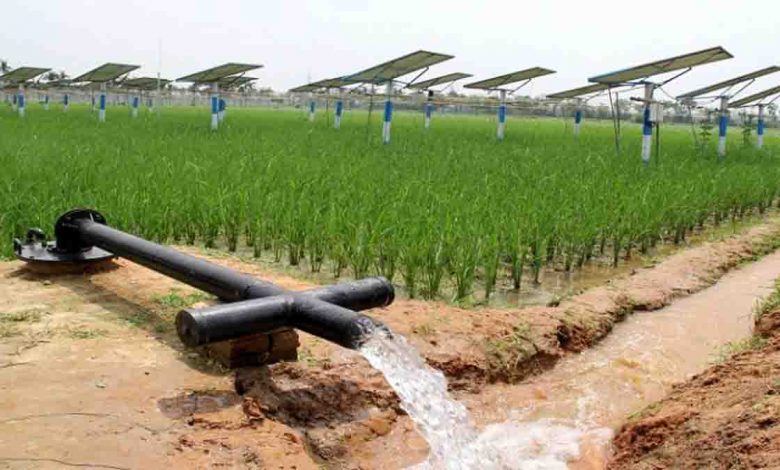The bane of water guzzling agriculture

 GUEST COLUMN
GUEST COLUMN
The ongoing farmers’ agitation is not a spontaneous event. It is one of the consequences of decades old discontent emanating from paradigm shift in agriculture beginning with the Green Revolution in 1960s. It would be wrong to think that only the new farm bills are at its roots. At its core, there are seeds of the Green Revolution which have enslaved farmers in various ways. And, above all, these poison-laden seeds have shattered the life base with which the society is nurtured and on the strength of which we dream of a safe future. A natural resource that has been most whipped off by our modern farming is the groundwater of the earth.
Now, a study has ascertained that indiscriminate exploitation of groundwater is resulting in sinking of land worldwide. The study conducted by the American Association for the Advancement of Science is based on the study of 1,596 cities out of 7,343 major cities selected in the world’s potential land subsidence areas. Most of the areas of land subsidence affected by groundwater exploitation are located in Asia, with about 64 crore people residing there. According to a report by The Guardian, countries like India, China and Mexico are rapidly draining groundwater to meet their food demands. Agriculture is at the forefront of excessive exploitation of groundwater.
Although the earth is a water planet with 70 per cent of it being covered by water, potable water is just 2.5 per cent of the total water, and it is this scarce water which is used to irrigate food crops. In the pre-Green Revolution agriculture, or traditional Indian agriculture, the need for water for irrigation was very low. Most of the food production in that period came from rainfed agriculture in which crops were dependent only on soil moisture maintained by rainwater.
The most astonishing truth in the world of our era is that about 72 per cent of the limited drinking water is guzzled by our modern agriculture – agriculture built around the Green Revolution. Water scarcity is a very big national issue in itself. Major cities in the country, including several regions of the country and the national capital are reeling under water crisis. The water crisis is deepening to the extent that food security is not guaranteed in the near future. The national food security arising out of the Green Revolution, in fact, is at the cost of water security. Food security is important. Water security is even more important. Three-fourths of the 2.5% of water on which human societies, all wild and domesticated animals, industry, commerce and socio-economic systems have also to be dependent, is used by agriculture alone—it should be considered as the biggest crisis arising out of the Green Revolution.
The said study has also revealed some formidable facts. It says that the city of Jakarta in Indonesia has sunk up to two-and-a-half metres in the last decade due to overexploitation of groundwater. Even if the subsidence is only a few centimeters, it is considered to be of alarming proportions. But here, it is in meters. The study also brought out the fact that 25 per cent of the Netherlands is below sea level and most of the areas are prone to land subsidence. The study also mentions that when the sea level increases due to global warming, the threat to the global population will become even more frightening.
India ranks first in the exploitation of groundwater worldwide. According to NITI Aayog, the number of major cities with zero ground water status is increasing. Rainwater harvesting is being made mandatory by the State governments. But due to lack of awareness among the citizens as well as lack of implementation, the groundwater crisis is deepening.
The sinking of the land is a major problem, the soil is also losing its moisture, and gradually advancing towards desertification. Dung, compost, green manure, etc. were of great value in maintaining moisture in the soil, but the seeds of the Green Revolution need chemical fertilisers, pesticides and vast quantities of water.
All our catering is dependent on agricultural products and the price of each product has to be paid with water. Wheat and rice are our two major crops covering the largest cultivated area. About 1,500 litres of water are consumed in producing one kilogramme of wheat and 2,497 litres in producing the same qiuantity of rice. India is the second largest producer of sugarcane in the world. Uttarakhand (Terai Region), Uttar Pradesh, Maharashtra, Karnataka, Tamil Nadu, Andhra Pradesh, Bihar, Gujarat, Haryana, and Punjab are the main Indian states cultivating sugarcane. Sugarcane production gulps water at the rate of 150,000 to 300,000 litres per quintal.
In California, USA, where 80% of pure water is used for irrigation of cultivated crops, about one million acres of agricultural land is used for growing alfalfa as a fodder crop, which is exported to China. An article in the New York Times has expressed concern that the US exports one billion gallons of water to China as alfalfa per year.
The water of the earth is a natural resource on which our food security, health security, economic security, environmental security etc depend. Unfortunately, our state and local body governments are not aware of this alarming threat. From sowing the seeds of the Green Revolution to harvesting them, the tube wells are being operated round the clock to suck out groundwater, and nobody is even bothered— neither the governments nor the farmers. In many of the Green Revolution areas of the country, groundwater has gone too deep for the motors of tubewells to extract. The concern is just to get electricity for free. What an irony that governments are elected on promises of free electricity and the crisis deepens. When electricity is free, the motors of the tubewells never stop. And now there are evidences from many regions in the world that the land under our feet is sinking into the abyss.
A paper in the famous research journal Science estimates that by the year 2040, as many as 1,20,000 square kilometres of land will be under serious threat due to subsidence on account of extraction of natural gas, oil and groundwater. Although groundwater is also extracted indiscriminately for fulfilling the requirements of industries, supplying water for populations especially in urban areas, our modern farming is in the first place to pull the largest proportion of the groundwater.
The research team’s scientists warn that there will be an unprecedented increase in the demand and scarcity of groundwater for global population and economic development in the coming decades. It is also mentioned in the report that in the last century subsidence due to overexploitation of groundwater was observed at least at 200 places in 34 countries.
As the water from the underground reserves is pulled out of the deeper layers, the upper land moves downwards to fill the gap. As the global warming is causing melting of glaciers and poles, the water level of the seas is increasing, the risk of sinking of beach cities will further increase when groundwater is being rapidly depleted.
There are also traditional seeds of traditional crops, like finger millet (mandua), barnyard millet (jhangora), pearl millet (bajra), sorghum (jowar), amaranth (ramdana or chulai) etc. that are grown in many areas of the country and can be produced without irrigation. There are many traditional species of wheat and paddy which can be grown on rainfed lands, and this is happening in many places. The mountain areas of Uttarakhand and Himachal Pradesh are examples of non-irrigation cultivation. The governments of many states are promoting cultivation of pulses and oilseeds so that water can be saved. But our agricultural policy does not reflect on the conservation of groundwater reserves, crops needing minimum water and also seeds that can tolerate drought conditions. The strategies for coordination and balance between the synergy of agro-health and food security, water security and environmental protection are also out of our national agricultural policy. And the biggest concern is that even the farmer leaders never want these issues to be raised.
About 80 million people in the country do not have easy access to drinking water. In this dismal state of the environment, what is the logic behind managing water-guzzling agriculture when alternatives are there? There is much hue and cry on food security, but there is eerie silence over water security! Is sustainable food security possible without water security?
(The author is a former professor of Environmental Science in GB Pant University of Agriculture and Technology)
Monday, 22 March 2021 | Vir Singh







Good paper
Share your experience in Agricaqua Science Research Journal
http://www.agriaquascirnce.com
Source of immense knowledge…..
Very well written. Language is powerful.
However, it is a known fact that food production can not be compromised for many years to come. Your observations to select less water guzzling crops and irrigation water conservation practices are worth analysis and adoption.
Dr. B. S. Bisht